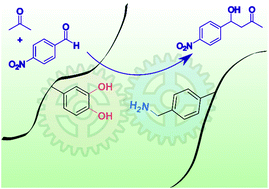Engineering of polystyrene-supported acid–base catalysts for aldol condensation in water†
Abstract
Aldol reaction in water can effectively limit the formation of Schiff bases that deactivate active amine sites. To date, regulation of cooperative behaviors and morphologies of polymer-supported acid–base catalysts remains a challenge. Here, we develop a controllable strategy for engineering polystyrene-supported acid–base catalysts by using nanoprecipitation in water. Benzylamine-containing copolymers and catechol-containing copolymers were synthesized and used for nanoprecipitation. Because of the hydrophobic nature of the polystyrene chains, coil-globule collapse not only constructs hydrophobic environments but also brings catechol groups and benzylamine groups in close proximity to enable the synergistic effect. The influence of polymer compositions and effective constituent ratios on catalytic performance was investigated to understand the structure-activity relationships. A postulated catalytic mechanism for polystyrene-supported acid–base catalysts was proposed. Our results demonstrate that this strategy provides access to more efficient polymer-supported acid–base catalysts and has the potential for the construction of other bifunctional catalytic systems in aqueous media.



 Please wait while we load your content...
Please wait while we load your content...